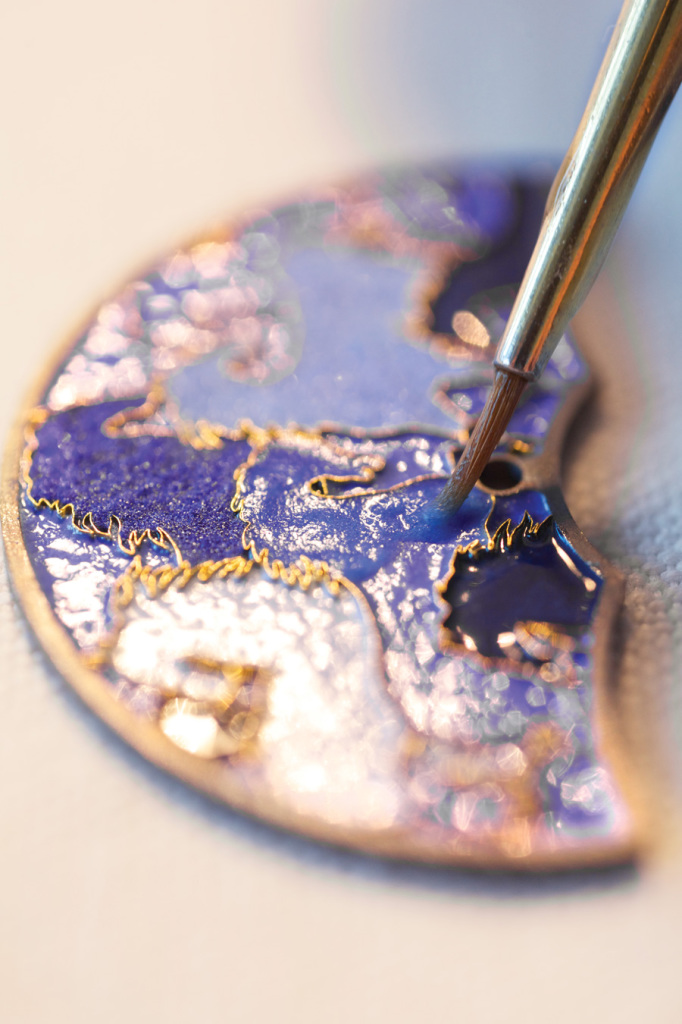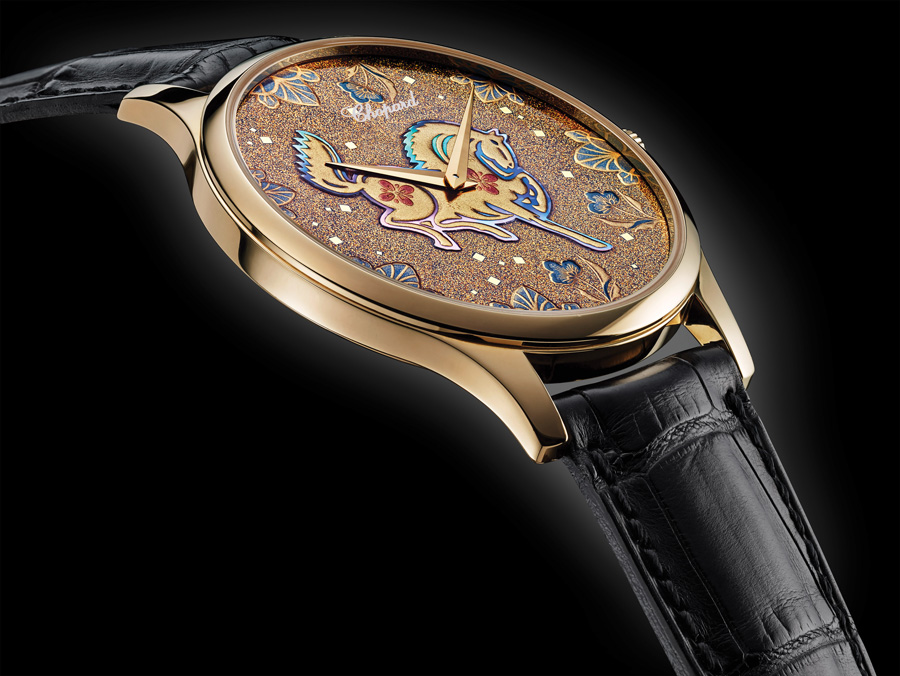Today’s master artisans in watchmaking utilize many typs of techniques to create stunning enamel worked dials. Masterpieces in miniature – that’s the best way to describe the stunning, artful beauty of a hand-painted watch dial. Imagine recreating the depth and allure of a full-scale painting on a miniscule canvas measuring just shy of two inches in diameter. This is what some of the most skilled artisans in the world do daily for the finest watch brands in the world.
Hand painting a watch dial – with a single color or an array of colors that come together to form scenes, birds, animals, flowers, people, geometric designs, mythical beasts and just about anything one can imagine – is no easy feat. In fact, it can take hundreds of hours depending on the complexity of the image. Additionally, there is risk of damage at every step – rendering the dial unusable – and demanding the artist go back and start it all again.
Enamel types
There are many types of hand-decorating techniques employed in watch dials – from painting, to enameling, cloisonné work and other methods. Each fusion of art and haute horology requires a different approach. Though in the end, it is the emotional connection to the design and technique that truly stirs the heart and signals the buyer’s choice.
While the host of mediums through which the watch brands work to achieve the end result of art for the wrist is constantly evolving – often with a blend of several coming together in one timepiece – certain techniques are among the most revered. Enamel work, for instance, with roots that are centuries old, is one of the most time-honored traditions in the art of watchmaking, requiring a skilled and steady hand, as well as a deep knowledge of the colors and the firing processes.
Essentially, enamel is a soft glass composed of silica, red lead and soda that, when mixed with other elements, is capable of creating intense hues with alluring depth. The artist creates colors by crushing the stones and mixing the enamel with different elements such as iron (which creates yellow, green and brown hues), chromium (offering green tones), iodine (yielding fiery reds), copper (unleashing hues of blue, green and red) and manganese (creating black and violets). Each enameler mixes his or her own colors with oil to achieve the perfect consistency for painting.
Typically, an enameler peers through a microscope or a loupe and wields a single-hair brush to create amazing likenesses. Every enamel watch dial undergoes multiple paintings and, hence, multiple firings, in a kiln at a temperature of well over 1,400 degrees fahrenheit – where the extreme heat subjects it to the possibility of paint bubbles, cracks, dust or even breakage, all of which would render the dial useless, forcing the enameler to start again.
To achieve a depth of color or translucency, for instance, a dial can require dozens of paintings and with every single painting of color; the dial must be fired to harden the paint before proceeding to the next step, subjecting it to dangers again and again.
Enamel work is a fine art of layering colors and portions of scenes time and again before finally resulting in a superb and sublime finish. Because every single watch dial is hand painted, each is unique – and all are rare.
Among the different styles of enameling: grand feu, cloisonné (with strips of gold outlining the design), champlevé, flinque and spangle (with gold foil decorations sunken into the enamel). There is also freehand enameling, wherein the artist creates or develops his or her own technique via a combination of methods and styles, and creates from mind’s eye to watch dial – with passion and patience. Such creations can take hundreds – even thousands – of hours to complete and, as such, they naturally command high prices and often carry a waiting list. Because each piece is individually hand painted, each is unique.
A host of today’s finest Swiss watch brands excel at the art of enamel , offering enchanting dials that capture hearts and eyes. Vacheron Constantin, for instance, has long been a user of this ancient technique, often blending enamel work, cloisonné and even gem setting on one single dial. In fact, the brand created a series that was in “Tribute to Famous Composers” such as the Chagall & L’Opera de Paris – before moving on to its incredibly loved Métiers d’Arts collection. Earlier this year, Vacheron Constantin released the Métiers d’Arts collection for women utilizing several techniques, including enamel and pearl and gem-stone setting.
Sometimes brands turn to new techniques and rekindle old techniques for the decoration of their artistic painted dials. Jaquet Droz, for instance, uses both hand painting on a porcelain dial, as in the case of its distinctive watches unveiled earlier this year celebrating the Year of the Horse, and also frequently makes dials with paillonne enameling.
First implemented in the eighteenth century, paillonne enameling has been revived and put to the test in this new collection of three models (a Petite Heure Minute, a pocket watch and a Grande Secondes watch) that is a marriage of gold and azure work. The firings for these dials are at temperatures close to 1,000 degrees celsius, and it is up to the trained eye of the artist to determine when the firing is complete – albeit when the motif (created by gold paillons meticulously placed on the dial) has set under the translucent enamel color.
Girard-Perregaux this year has introduced three limited edition watches utilizing miniature enamel painting on a white enamel base plate, and cloisonné (wherein thin gold wires outline the design and the enamel is then filed in) to depict Arabian horses, a world map and other designs.
In typical Chopard style, the brand has captured the quintessential Japanese art form (the dancing horse) working in Urushi and Maki-e techniques on the dial. A host of different dial motifs have been created in this format, which uses gold and lacquer or varnish that is made from the sap of the Urushi tree.
Similarly, Cartier, Bovet, Ulysse Nardin, Van Cleef &Arpels and others have brought the art of enamel to life in glorious detail, yielding watches with designs that have been masterfully reproduced in miniature thanks to the artisans who conceive of, create and work tirelessly to bring their expressions to fruition. (A version of this article by Roberta Naas first appeared in IW Magazine.)






